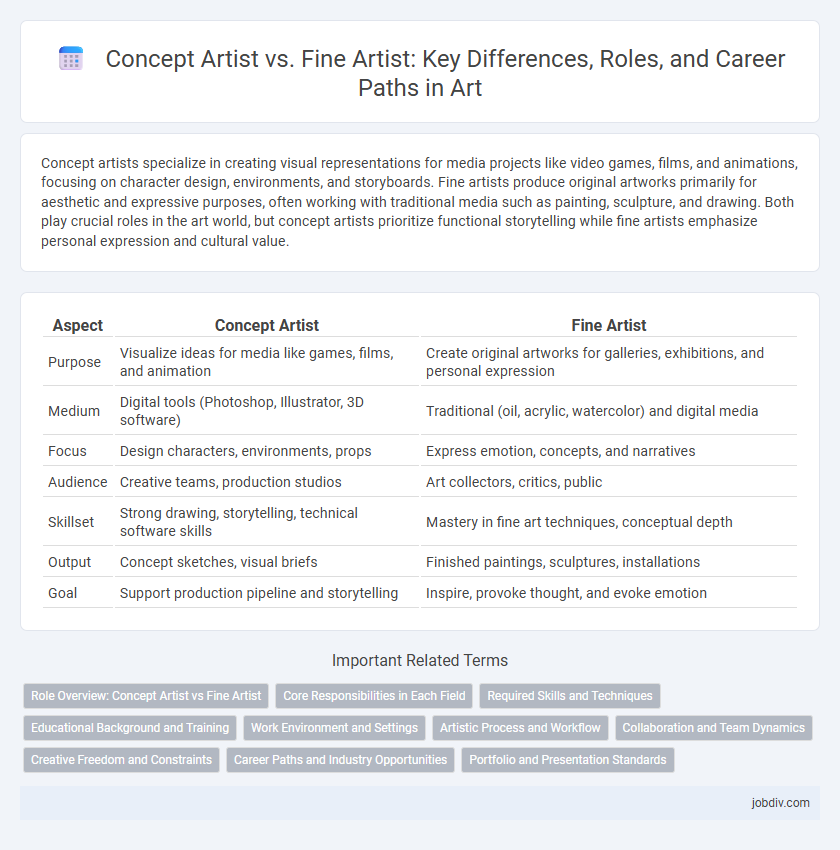Concept artists specialize in creating visual representations for media projects like video games, films, and animations, focusing on character design, environments, and storyboards. Fine artists produce original artworks primarily for aesthetic and expressive purposes, often working with traditional media such as painting, sculpture, and drawing. Both play crucial roles in the art world, but concept artists prioritize functional storytelling while fine artists emphasize personal expression and cultural value.
Table of Comparison
| Aspect | Concept Artist | Fine Artist |
|---|---|---|
| Purpose | Visualize ideas for media like games, films, and animation | Create original artworks for galleries, exhibitions, and personal expression |
| Medium | Digital tools (Photoshop, Illustrator, 3D software) | Traditional (oil, acrylic, watercolor) and digital media |
| Focus | Design characters, environments, props | Express emotion, concepts, and narratives |
| Audience | Creative teams, production studios | Art collectors, critics, public |
| Skillset | Strong drawing, storytelling, technical software skills | Mastery in fine art techniques, conceptual depth |
| Output | Concept sketches, visual briefs | Finished paintings, sculptures, installations |
| Goal | Support production pipeline and storytelling | Inspire, provoke thought, and evoke emotion |
Role Overview: Concept Artist vs Fine Artist
Concept artists specialize in creating visual representations that guide the development of video games, films, and animations, focusing on imaginative and functional designs. Fine artists concentrate on producing original works intended for aesthetic appreciation and expression, often using traditional media like painting and sculpture. Both roles demand strong artistic skills, but concept artists emphasize storytelling for media production, while fine artists prioritize personal creativity and gallery exhibitions.
Core Responsibilities in Each Field
Concept artists specialize in creating visual representations for characters, environments, and props to guide the development of video games, films, and animations, emphasizing rapid ideation and clear communication of ideas. Fine artists focus on producing original works such as paintings, sculptures, and installations intended for exhibition or sale, prioritizing personal expression and mastery of traditional media techniques. Both roles demand strong artistic skills, but concept artists prioritize functionality and collaboration, while fine artists emphasize individuality and aesthetic exploration.
Required Skills and Techniques
Concept artists excel in digital tools like Photoshop and Blender, emphasizing speed and versatility to create visual narratives for games and films. Fine artists concentrate on traditional techniques such as oil painting and sculpture, mastering color theory and composition to evoke emotion and personal expression. Both fields demand strong observational skills, creativity, and a deep understanding of anatomy and perspective to produce compelling artwork.
Educational Background and Training
Concept artists typically pursue specialized education in digital art, animation, or game design, emphasizing technical skills and software proficiency like Photoshop and Blender. Fine artists often follow traditional art education paths, such as Bachelor of Fine Arts (BFA) programs, focusing on drawing, painting, and sculpture to develop a strong foundation in classical techniques. Both paths require intensive practice, but concept artists lean towards industry-driven training, while fine artists prioritize artistic expression and theory.
Work Environment and Settings
Concept artists typically work in dynamic studio environments, collaborating closely with game developers, filmmakers, and designers to create visual concepts for characters, settings, and props. Fine artists often work in private studios or home workshops, focusing on individual creativity and producing original artwork for galleries, exhibitions, and personal collections. The structured deadlines and digital tools of concept art contrast with the more autonomous, traditional mediums and flexible schedules preferred by fine artists.
Artistic Process and Workflow
Concept artists focus on rapid iteration and visual storytelling to develop characters, environments, and assets primarily for games and films, using digital tools like Photoshop and Blender to refine ideas efficiently. Fine artists emphasize personal expression and craftsmanship, often employing traditional mediums such as oil paint or sculpture, with a workflow centered around exploration and gradual detail enhancement. The artistic process for concept artists is collaborative and time-sensitive, while fine artists operate more independently with flexible pacing.
Collaboration and Team Dynamics
Concept artists drive the visual development of projects by creating detailed designs and storyboards that guide production teams, while fine artists focus on personal expression and completing standalone artworks. Collaboration between concept artists and fine artists enhances creative workflows, blending structured ideation with unique artistic perspectives to enrich team outputs. Strong team dynamics emerge from clear communication, mutual respect for different artistic processes, and shared goals in delivering compelling visual narratives.
Creative Freedom and Constraints
Concept artists prioritize creativity within project guidelines, crafting visuals to support narratives in games or films, often working under client-imposed constraints and deadlines. Fine artists enjoy greater creative freedom, expressing personal vision without strict boundaries, allowing exploration of diverse styles and themes for galleries or personal fulfillment. Both roles require skill and originality, but concept artists balance innovation with collaboration, while fine artists pursue individualistic expression.
Career Paths and Industry Opportunities
Concept artists primarily work in entertainment industries such as video games, film, and animation, creating visual designs that bring ideas to life and influence production pipelines. Fine artists often pursue careers centered on galleries, exhibitions, and art sales, relying heavily on personal style and creative expression to build their reputation and income. Both career paths offer distinct opportunities: concept artists benefit from collaborative, fast-paced environments with steady project work, while fine artists enjoy more autonomy but face greater challenges in market visibility and financial stability.
Portfolio and Presentation Standards
A concept artist's portfolio emphasizes versatility and clear visual storytelling, showcasing character designs, environments, and dynamic scenes that demonstrate adaptability to various creative briefs. Fine artists prioritize a cohesive body of work reflecting personal style and technique mastery, with presentations targeting galleries and collectors through high-quality prints and well-curated exhibitions. Both portfolios demand high-resolution images and professional layouts, but concept artists must also include process work and iterations to highlight problem-solving skills and creativity under constraints.
Concept Artist vs Fine Artist Infographic

 jobdiv.com
jobdiv.com